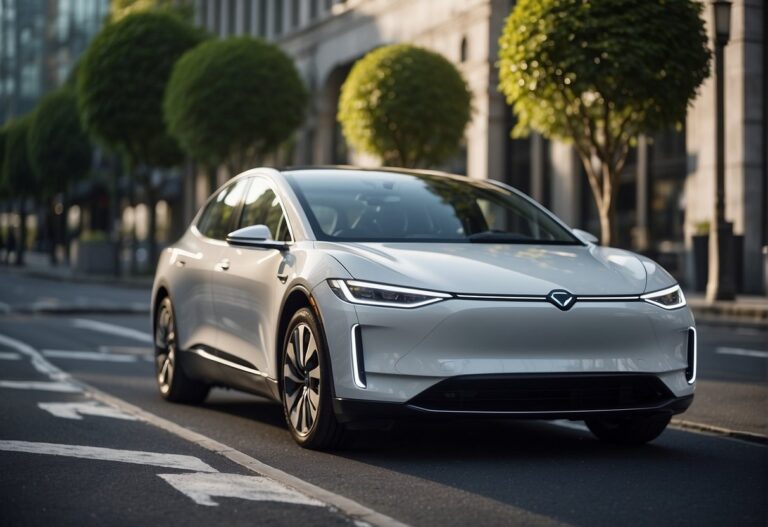Electric vehicles (EVs) have become increasingly popular in recent years due to their environmental benefits. However, EVs are still relatively expensive compared to traditional gasoline-powered cars, which makes them inaccessible to many people. Carpooling and shared mobility solutions can help address this issue by providing an affordable and sustainable way for people to access EVs.
Carpooling involves sharing a ride with others who are going in the same direction. This not only reduces the number of cars on the road but also helps to reduce traffic congestion and air pollution. Additionally, carpooling can be a cost-effective way to travel, as the cost of fuel and other expenses can be shared among the passengers.
Shared mobility solutions, such as peer-to-peer car-sharing and ride-sharing, are also becoming increasingly popular. These services allow people to share cars and rides with others, which can help to reduce the number of cars on the road and promote sustainable mobility. Additionally, shared mobility solutions can be more affordable than owning a car, as users only pay for the time they use the vehicle. With the rise of EVs, shared mobility solutions are becoming an increasingly important part of the sustainable mobility landscape.
Environmental and Social Benefits of EV Carpooling
Reducing Emissions and Air Pollution
EV carpooling is a shared mobility solution that can significantly reduce greenhouse gas emissions and air pollution. By pooling resources and sharing a ride, EV carpooling can decrease the number of vehicles on the road and, in turn, reduce carbon emissions. This reduction in emissions leads to cleaner air and a healthier environment, which benefits both individuals and communities.
Alleviating Traffic Congestion and Infrastructure Strain
EV carpooling can also alleviate traffic congestion and infrastructure strain. By reducing the number of cars on the road, EV carpooling can help ease traffic congestion and reduce the need for additional infrastructure, such as new roads and parking lots. This can lead to more efficient and sustainable transportation systems, which benefit both individuals and cities.
Promoting Community and Social Connections
EV carpooling also promotes community and social connections. By sharing a ride with others, individuals can build trust and form connections with their fellow carpoolers. This can lead to a stronger sense of community and social connections, which can benefit individuals and communities alike.
Overall, EV carpooling is a shared mobility solution that offers significant environmental and social benefits. By reducing emissions and air pollution, alleviating traffic congestion and infrastructure strain, and promoting community and social connections, EV carpooling can help create more sustainable and livable cities.
Economic and Efficiency Advantages of Shared Mobility Solutions
Shared mobility solutions offer several economic and efficiency advantages over traditional vehicle ownership. These advantages include cost savings and economic incentives, enhancing transportation efficiency and accessibility, and innovation in shared mobility business models.
Cost Savings and Economic Incentives
Shared mobility solutions can help individuals save money on transportation costs. By sharing vehicles, individuals can split the cost of ownership, maintenance, and fuel. Additionally, some shared mobility providers offer incentives such as discounts, rewards, and promotions to encourage individuals to use their services.
Enhancing Transportation Efficiency and Accessibility
Shared mobility solutions can also enhance transportation efficiency and accessibility. By utilizing shared vehicles, individuals can reduce the number of vehicles on the road, which can lead to reduced traffic congestion and improved air quality. Additionally, shared mobility solutions can provide individuals with access to transportation in areas where public transit is limited or unavailable.
Innovation in Shared Mobility Business Models
Shared mobility solutions have also led to innovation in business models and technologies. For example, some shared mobility providers offer peer-to-peer car sharing, which allows individuals to rent out their personal vehicles to others. Additionally, some shared mobility providers are exploring the use of autonomous vehicles and other technologies to improve efficiency and accessibility.
Overall, shared mobility solutions offer several economic and efficiency advantages over traditional vehicle ownership. By utilizing shared vehicles, individuals can save money on transportation costs, enhance transportation efficiency and accessibility, and benefit from innovation in shared mobility business models and technologies.
Frequently Asked Questions
What are the environmental advantages of electric vehicle carpooling?
Electric vehicle carpooling offers several environmental advantages. It reduces the number of vehicles on the road, which in turn lowers greenhouse gas emissions and air pollutants. This contributes to cleaner air, lessens the impact of climate change, and promotes a healthier environment. Additionally, electric vehicles emit zero tailpipe emissions, which further reduces air pollution.
How does shared mobility contribute to traffic congestion reduction?
Shared mobility solutions like carpooling, ride-sharing, and bike-sharing can significantly reduce traffic congestion. By reducing the number of cars on the road, shared mobility solutions help to alleviate traffic congestion, which can lead to a reduction in travel time and fuel consumption. This is particularly important in urban areas where traffic congestion is a major problem.
What cost savings can individuals expect from participating in EV carpooling?
Participating in electric vehicle carpooling can lead to significant cost savings for individuals. Carpooling enables individuals to share the cost of fuel, parking, and tolls, which can result in substantial savings over time. Additionally, electric vehicles are more fuel-efficient than traditional gasoline-powered vehicles, which can lead to further cost savings.
In what ways does shared mobility impact urban transportation efficiency?
Shared mobility solutions can significantly impact urban transportation efficiency. By reducing the number of cars on the road, shared mobility solutions can help to alleviate traffic congestion and reduce travel time. Additionally, shared mobility solutions can help to increase the utilization of existing transportation infrastructure, which can lead to more efficient use of resources.
How does the integration of EVs into shared mobility platforms enhance energy sustainability?
The integration of electric vehicles into shared mobility platforms can enhance energy sustainability in several ways. Electric vehicles emit zero tailpipe emissions, which reduces air pollution and contributes to a healthier environment. Additionally, electric vehicles can be charged using renewable energy sources like solar and wind power, which further reduces their environmental impact.
What are the societal benefits of adopting shared mobility solutions?
Adopting shared mobility solutions can have several societal benefits. By reducing the number of cars on the road, shared mobility solutions can help to alleviate traffic congestion, which can lead to a reduction in travel time and fuel consumption. Additionally, shared mobility solutions can help to increase access to transportation for individuals who may not have access to a car, which can promote social equity and inclusion.



